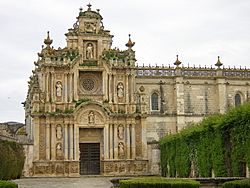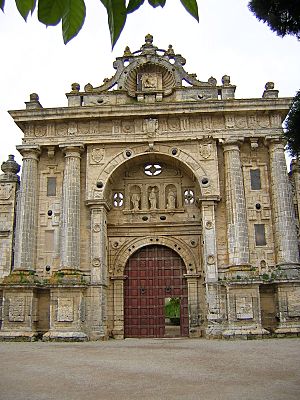Jerez de la Frontera Charterhouse facts for kids
 |
|
| Monastery information | |
|---|---|
| Other names | Cartuja de Santa María de la Defensión Cartuja de Nuestra Señora de la Defensión |
| Order | originally Carthusians; now Sisters of Bethlehem, of the Assumption of the Virgin and of Saint Bruno |
| Architecture | |
| Heritage designation | Property of Cultural Interest |
| Site | |
| Location | Jerez de la Frontera, Cádiz, Spain |
| Coordinates | 36°39′17.56″N 6°5′36.68″W / 36.6548778°N 6.0935222°W |
| Charterhouse of Jerez de la Frontera | |
|---|---|
| Native name Spanish: Cartuja de Jerez de la Frontera |
|
 |
|
| Location | Jerez de la Frontera, Spain |
| Official name: Cartuja de Jerez de la Frontera | |
| Type | Non-movable |
| Criteria | Monument |
| Designated | 1856 |
| Reference no. | RI-51-0000004 |
| Lua error in Module:Location_map at line 420: attempt to index field 'wikibase' (a nil value). | |
The Charterhouse of Jerez de la Frontera (Spanish: la Cartuja de Jerez de la Frontera) is a famous old monastery in Jerez de la Frontera, Spain. It is also known as the Charterhouse of Santa María de la Defensión.
This beautiful building shows off two main styles of architecture. It started with a Late Gothic design when construction began in the 1400s. Later, in the 1600s, Baroque elements were added. The monastery was finished in the 17th century. The Spanish government has protected it as an important historical site since the mid-1800s.
Some parts of the monastery are especially interesting. The main entrance, built in the Renaissance style, was designed by Andrés de Ribera. You can also see the Chapel of Santa María and a small Gothic cloister (an open courtyard) designed by Juan Martínez Montañés. The special seats for the choir were made by Juan de Oviedo de la Bandera. These seats were moved here in 1960 from another church. Paintings by Juan de la Roelas also came from that same church. On the other hand, many paintings by Francisco Zurbarán that were originally from this monastery are now kept in the Museo de Cádiz (a museum in Cádiz).
Today, the monastery is home to the Sisters of Bethlehem. They continue the long Roman Catholic tradition of prayer and spiritual life that was started over five centuries ago by the Carthusian fathers.
Contents
History of the Monastery
The idea for this monastery began with a knight named Alvaro Obertos de Valeto. He was from Genoa and was chosen by King Alfonso X of Castile to protect the city of Jerez after it was taken from Muslim rule in 1264. Since Alvaro had no children, he left his money to build a Carthusian monastery in the city.
It took a long time for the monastery to be built. In 1475, this specific spot near the Guadalete River was chosen. This location was special because a big battle was won here in 1368. People believed the Virgin Mary helped them win, so a small chapel (a hermitage) was built there. It was called Nuestra Señora de la Defensión ("Our Lady of the Defense"), and this name was also given to the new monastery.
Architectural Features
At the entrance of the monastery, there is a wide archway called a portico. It has a large central arch and two heavy wooden doors decorated with bronze. This entrance was started in 1571 by a local architect named Andrés de Ribera. It is a great example of Renaissance architecture from the region of Andalusia. It looks like a grand triumphal arch and is decorated with coats of arms, fancy windows, and glazed ceramic domes.
In the early 1600s, when the first building plans were almost done, new work began. The front of the church was completely rebuilt in 1667 in a clear Baroque style. This was based on the plans of Brother Pedro del Piñar. He also added sculptures by Francisco de Gálvez to the tops of the church and dining hall.
This church front looks like a huge stone altarpiece. It has two levels of Corinthian columns and curved designs. It is decorated with pilasters (flat columns), friezes (decorated bands), and many vases. This makes the façade a unique example of Andalusian Baroque art.
Inside the monastery, the choir stalls in the Coro de Padres are very impressive. They are made of carved wood and were finished in 1550. The old altarpiece was replaced by works from artists like Alejandro de Saavedra, José de Arce, and Francisco de Zurbarán. Many of Zurbarán's paintings that were originally on the walls of the sanctuary are now in the Museo de Cádiz.
Impact of War
In 1810, during the Peninsular War (when France invaded Spain), French soldiers used the monastery as a barracks. They damaged or destroyed much of the complex that had been built over three centuries. The monks had to leave and find safety in Cádiz. When they returned, the monastery was empty and ruined.
Conservation and Access
After the war, the monastery was repaired and brought back to its original use. Today, it is in good condition. It was named a Monumento nacional (a national monument) in 1856. This made it one of the first places in Spain to receive such an important title. More recently, it has been called an Historic-Artistic Monument.
You can reach the monastery by taking the CA-2004 road, which you can get to from the Autovía A-381 highway.
See also
 In Spanish: Cartuja de Jerez de la Frontera para niños
In Spanish: Cartuja de Jerez de la Frontera para niños

